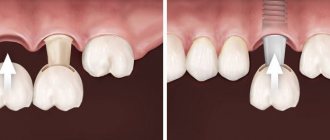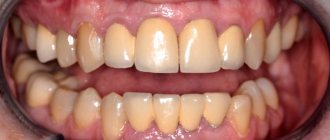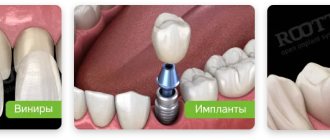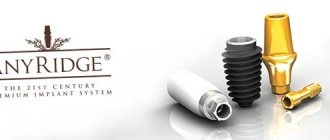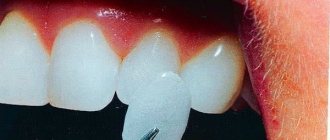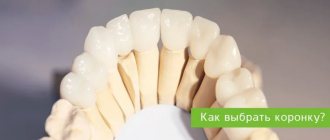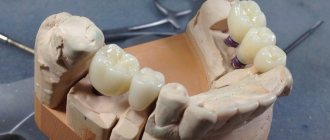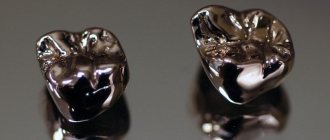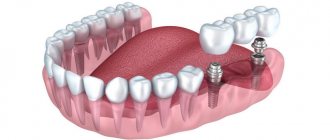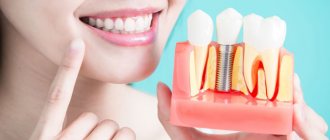A bridge is a fused orthopedic structure used to replace one or more missing teeth in a row, usually one to three. Before the advent of implantation, bridges were used everywhere. In terms of their advantageous characteristics, classical bridges are unlikely to be able to compete on equal terms with implantation. However, each technique has its own disadvantages and contraindications, so the choice is made after analyzing a number of factors.
Pros of installing an implant
During implantation, the artificial root serves as a support for the crown. Most often, high-strength titanium is used, which ensures complete inertness. This eliminates the risk of rejection and allergic reactions. Implants fully perform the functions of teeth: they restore chewing efficiency, are responsible for uniform load on the jaw bone, and maintain the shape of the gums. The appearance of an artificial neighbor does not affect the units located nearby, since titanium structures are implanted into the jaw bone, after which a crown or bridge is installed on them.
- reliability, strength, durability of structures;
- over time, bone tissue does not atrophy;
- no need to remove pulp from adjacent units;
- With proper care they can last a lifetime.
- relatively high cost;
- the presence of contraindications (diseases of the circulatory system, oncology, HIV, decompensated diabetes mellitus, diseases of the immune and endocrine systems, scleroderma, lupus erythematosus, etc.);
What does the cost consist of?
Our Center provides a case payment system
The implant installation case includes:
- local anesthesia;
- cost of the Nobel Biocare implant and its installation;
- consumables and superstructures;
- applying and removing sutures;
- control CT diagnostics after surgery.
The case for installing a bridge includes:
- taking impressions;
- production of prosthesis;
- fitting and fixation of the structure.
Paid separately:
- Diagnostic case before implantation - the cost depends on the necessary studies.
- Osteoplastic surgery if necessary - the price is calculated depending on the type of bone augmentation and the duration of the defect.
- Sedation - calculated for each hour spent in medicated sleep. Usually 1 hour is enough to install 2-3 implants.
The total cost of bridge prosthetics on implants is formed taking into account:
- length of the defect;
- type and number of implants;
- number of crowns in the structure;
- the need for osteoplasty;
- use of sedation.
Pros and cons of classic bridges
- Not bad functionality.
- Fewer contraindications compared to implantation.
- In terms of cost, this is a more budget-friendly restoration option.
- The need for turning. The procedure usually requires depulpation of healthy supporting teeth.
- Lack of load provokes bone tissue atrophy.
- Mediocre aesthetics.
Disadvantages of implants
As with any treatment method, even the most modern and popular, the implantation method also has disadvantages. These include:
- a large number of different contraindications;
- high cost and inaccessibility for patients with low incomes;
- long stages of implantation, lasting up to a year.
Installing implants requires contacting qualified and skilled specialists. In this case, the dentist must thoroughly examine the patient and think through a treatment plan.
Successful implantation of the structure requires strict adherence by the patient to all instructions and prescriptions of the specialist doctor. This will avoid dangerous postoperative complications.
Bridge or implant on the front tooth?
When restoring teeth in the smile area, implantation is recommended. If several teeth are missing at once, it is better to replace them separately (one tooth - one implant). However, an option with a bridge prosthesis is also possible, but with support on artificial roots, and not on the patient’s own teeth. A combination of two techniques (implantation and bridge installation) is used in cases of the absence of several teeth in a row or their complete loss. In this case, the number of supporting implants depends on the duration of the bridge structure. This method of restoration eliminates the grinding of healthy teeth and ensures a reliable connection of the prosthesis to the jaw. Dentures on implants last longer than bridges installed on natural teeth.
Classic bridges on the front teeth are also one of the solutions, especially in the case of absolute contraindications to implantation or with limited financial resources. Modern bridges can be made of solid ceramics or zirconium: for front teeth this will be the best option, but it will be more expensive than conventional metal-ceramics.
Caring for implant bridges
A brush, paste, rinse and irrigator are the main tools to achieve excellent oral hygiene every day. After each meal, you should rinse your mouth to remove food debris with water or mouthwash. After implantation, the gums become less sensitive, so you should use super-floss carefully.
It is necessary to visit the doctor once every six months for a preventive examination. It is also advisable to carry out comprehensive professional cleaning at least once a year.
Author:
What to choose for chewing teeth?
In the case of chewing teeth, functionality comes to the fore. A dental implant can withstand chewing loads one hundred percent. In the case of a classic bridge, all the “work” falls on the natural teeth on which the prosthesis is attached. Experiencing additional stress, over time, the supporting teeth are destroyed and deformed.
Complications after bridge installation
If the patient nevertheless decides to install bridge structures, it is important for him to know about the following possible consequences of this method of prosthetics:
- Often, after dentures, patients begin to experience discomfort due to the adaptation of taste buds to the voids in the mouth. This may take several days.
- Unpleasant sensation from food getting under the denture. This is natural, since after prosthetics there is always a gap between the gum and the mouth, the so-called “washing space”. If the denture is placed tightly against the gums, this will lead to the formation of bedsores. You should see a dentist if the rinsing space is excessively large or if the prosthesis touches the gum at some point. Most often, the constant entry of food under the denture causes the destruction of the filling of the adjacent tooth or the new crown.
- To remove food debris, the patient must accustom himself to using a toothbrush, irrigator or superfloss.
- An unpleasant feeling of excessive convexity of the bridge at some points. It seems to the patient that in some places something is preventing the movement of the jaws. Such a nuisance can cause splitting of the denture or pain in the area of the supporting teeth. Therefore, in such cases, it is necessary to correct the protruding places of the structures at the dentist.
- Exposure of the neck of the tooth some time after the installation of bridges. This phenomenon can be considered a natural process due to the “creeping” of the gums. This unpleasant process can develop accelerated due to pathological processes of the gums or improper grinding of teeth (without the formation of a special ledge). To slow down the exposure of the gums, crowns are made from biocompatible materials with all-metal edges.
- Crowns often fall off in patients suffering from bruxism. With this disease, many types of prosthetics are contraindicated, since crowns and veneers may come off.
Dental bridge or implant - which is better from an economic point of view?
The question of what to install (a bridge or an implant) in the event of the loss of one or more teeth is also relevant from a financial point of view. If you are on a limited budget and cannot afford to restore your teeth with implants, choose bridge structures. But keep in mind that classic bridges have a limited service life and need to be replaced over time. In the long term, implantation is a more profitable option for restoring teeth, despite the fact that implant-supported dentures are the most expensive. For example, one budget category implant and metal-ceramic crown will cost approximately 35,000 rubles: premium implants and prostheses can double this amount.
Classic bridges are cheaper: the price for a bridge of three crowns starts from 30,000 rubles. Designs made of ceramics and zirconium dioxide will cost more. For example, a ceramic bridge made using E-max technology costs from 60,000 rubles. Agree, this amount does not fit into the budget solution. In addition, the price of installing a classic bridge does not include the cost of preparing supporting teeth, while depulpation of one molar can cost more than 5,000 rubles. Add to this amount further expenses for replacing the prosthesis. As a result, the cost of a conventional bridge will be comparable to the cost of implantation.
What materials are they made of?
Dentures are manufactured in the Center’s own dental laboratory, you can choose the appropriate option to suit your taste and budget
- Metal-ceramic The base of the crowns is a metal alloy, the top is covered with ceramic mass. Relatively inexpensive, yet durable and quite aesthetic. The main disadvantage of metal ceramics is the ability to oxidize and cause a bluish outline to appear on the gums over time. Service life - 15 years or more .
- Zirconium Can be all-zirconium or coated with ceramics. They can withstand any load, do not deform, and retain their original appearance. Identical to natural teeth, the shade is selected individually. More expensive than metal-ceramic ones, but last longer. Service life - 25 years or more.
We offer patients the most profitable and practical methods, so we reserve the advantage for metal-free structures. In our Center, dental bridges are created in our own digital production using Zirkonzahn Schule technology or at the PROCERA (Nobel Biocare) plant in Sweden.
Implantation.
Implants are a much more advanced, technologically and practically complex technique, but this is the only option at the moment for replacing missing teeth, which returns patients the opportunity to fully chew, smile, and live a normal life without affecting the neighboring teeth next to the removed one.
The main disadvantages are:
- The cost is higher
(but this is not always the case - for example, the return of one missing tooth using the implantation technique comes out to approximately the same cost as the manufacture of a bridge with the preparation of teeth for prosthetics under standard conditions in terms of bone tissue volume). - The timing of return is a controversial point
. Nowadays they often use one-stage loading under good conditions - this is when, when placing an implant, a temporary crown is immediately made and it turns out that this option is the fastest, since making a bridge requires 1.5-2 weeks plus therapeutic treatment of the supporting teeth 2-4 visits, and this is still a week. And it turns out that by following the implantation method, the patient can get results almost immediately, but with bridge structures, 3 weeks and many visits (2-4 visits to the therapist, 3 to the orthopedist, 1 to the periodontist) there is a very large loss of time, which is very valuable for any person. - Fear of any surgical procedures
. Today, this is a solvable problem, given the presence of an anesthesiology department and the possibility of using sedation in the clinic, patients tolerate all manipulations calmly, comfortably and without fear.
The use of implants provides the patient with a number of advantages:
- There is no need to involve neighboring teeth
, i.e. there is no need to grind or depulp adjacent teeth. - Possibility of fairly quick prosthetics
: in some cases, an implant can be installed immediately after tooth extraction or after a short period of time, which shortens the standard work protocol by an average of 2-6 months. - The load on the bone that the implant transfers is comparable to natural
. Practice shows that if implantation is not delayed and the implant is placed immediately after removal, then bone atrophy will be only 2-3 percent. Thanks to this, it is possible to preserve the volume of bone ridge and gum necessary for aesthetics in order to recreate a beautiful smile. - The ability to use implants for a long time
(there is no service life and lifelong use is possible) due to the fact that the implant is made of titanium, which has high strength, wear resistance and hypoallergenicity. - Excellent integration
(survival) rates of implants (96-98%) due to the use of hypoallergenic materials. - The ability to use implants for removable prosthetics
when fixing removable and conditionally removable structures.
So the choice is yours and you need to take into account all the points and your wishes.
Complications after installation of implants
Unfortunately, occasionally (in 5% of cases) implantation can cause various complications. They can occur during the implantation operation, immediately after it, and after some time.
Most often, patients may encounter the following types of postoperative complications:
- bleeding (with low blood clotting);
- pain:
- seam divergence;
- perforation in the maxillary sinus (usually as a result of insufficient examination before implantation in the upper jaw);
- paralysis of the masticatory muscles after damage to the mandibular nerve;
- inflammatory process at the incision site;
- peri-implantitis (severe complication in the form of inflammation around the implant and its rejection).
In case of any trouble (pain, suture dehiscence, inflammation or bleeding), it is important for the patient to immediately call his doctor.
Prescribed hygiene and proper treatment of the postoperative wound are also important.
Peri-implantitis is more often observed in the first months after surgery. Occasionally, this extremely unpleasant consequence occurs much later for various reasons (prosthetic errors, burns during surgery or postoperative inflammation, bone pathology or patient diseases).
Occasionally, incorrect installation of implants also occurs, which seriously complicates further prosthetics. This is why it is important for an orthopedist and a surgeon to work as one team.
An experienced orthodontist can help the patient determine the appropriate implant design. We wish you to make the absolutely right choice!
Sources used:
- Ireland, Robert IrelandRobert (2010), Ireland, Robert (ed.), "Denture stomatitis", A Dictionary of Dentistry
- “Removable dentures: a textbook” (Mironova M.L.)
- “Partial removable dentures” (Zhulev E.N.)
- Glass, R; Goodson, L; Bullard, J; Conrad, R (2001). "Comparison of the effectiveness of several denture sanitizing systems". Compendium of Continuing Education in Dentistry.
